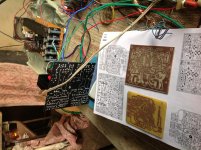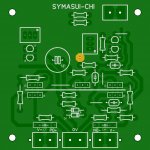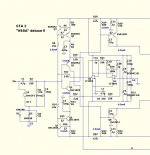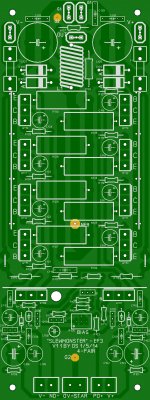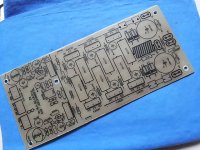I thought you can go without it (I hope, silver mica is not cheap 😀)
only additional if you face unstable condition
only additional if you face unstable condition
Yup, bli i think can go without it, but uncle Os has reserved it for something.
Even this Cap not drawn on schematic.
Even this Cap not drawn on schematic.
Hi Ostripper
greetings as i am a big fan of your amp designs so i have decided to build the
wolverine design just cant WAIT
warm regards
andrew
greetings as i am a big fan of your amp designs so i have decided to build the
wolverine design just cant WAIT
warm regards
andrew
Ostripper, two suggestions.. mirror in the driving currents from a floating CCS, then you transform a low impedance input of the servo to a high impedance CCS. That way the servo is optimally shielded from the signal path. (IRL I also operate a two op-amp solution with a 3. order LF-filter)
Also if you want to improve PSSR even further then mirror the current over to the VAS. This will also improve distortion a magnitude.
Also if you want to improve PSSR even further then mirror the current over to the VAS. This will also improve distortion a magnitude.
Hi Ostripper
greetings any replacement for 2SC911 2SA1209 hard to get these trs in my place
warm regards
andrew
greetings any replacement for 2SC911 2SA1209 hard to get these trs in my place
warm regards
andrew
Hi guys,
I was wonder the same thing, since 2SA1209_2SC2911 are not offered by Onsemi since they took over Sanyo semi op.
2SA1507-2SC3902
2SA1552-2SC4027
can be used to replace 2SA1209_2SC2911?
thx
Rick
I was wonder the same thing, since 2SA1209_2SC2911 are not offered by Onsemi since they took over Sanyo semi op.
2SA1507-2SC3902
2SA1552-2SC4027
can be used to replace 2SA1209_2SC2911?
thx
Rick
2SA1507-2SC3902 are excellent.Hi guys,
I was wonder the same thing, since 2SA1209_2SC2911 are not offered by Onsemi since they took over Sanyo semi op.
2SA1507-2SC3902
2SA1552-2SC4027
can be used to replace 2SA1209_2SC2911?
thx
Rick
2SA1552-2SC4027 are Big SMD. 😱
Mje340/350 can also be used.
OS
Hi uncle OS, there is something missing value on Cx (is this lead/lag comp?)
i am referring on slew-nadH IPS
That little Cx cap is a .1u 50v for decoupling the IC.
Added it later (no number).
OS
Symasym and ANOTHER CFA !
Almost done with the symasui. This would be a good amp for a subwoofer.
It has rock bottom LF THD.
It is (below 1-2).
Another is the "baseline" CFA , like the VSSA ... just 1 input pair/2 CCS's
and a super servo. (below 3).
PS - .ASC spice files for these 2 cool amps are also below 🙂 .
OS
Almost done with the symasui. This would be a good amp for a subwoofer.
It has rock bottom LF THD.
It is (below 1-2).
Another is the "baseline" CFA , like the VSSA ... just 1 input pair/2 CCS's
and a super servo. (below 3).
PS - .ASC spice files for these 2 cool amps are also below 🙂 .
OS
Attachments
Almost done with the symasui. This would be a good amp for a subwoofer.
It has rock bottom LF THD.
It is (below 1-2).
Another is the "baseline" CFA , like the VSSA ... just 1 input pair/2 CCS's
and a super servo. (below 3).
PS - .ASC spice files for these 2 cool amps are also below 🙂 .
OS
Why do you separate R20 and R21 on symasui? Is it any benefit than connect emitter Q8 and Q9 (like LTP) ?
Why do you separate R20 and R21 on symasui? Is it any benefit than connect emitter Q8 and Q9 (like LTP) ?
Yes , you noticed.. Running the active VAS semi's in a "LTP" like
configuration will create more gain and since it is like having NO
emitter resistors ... instability , as well .
The way it is now is just a fancy level shifter/"turn around" circuit that
gives you the other half of the symmetrical VAS.
This circuit only has 53dB LF loop gain , about the same as the "VSSA".
They are perfect "rumble" IPS's ... as they both simulate at 20-30ppm 1/2 power -20K.
The symasui is almost exactly like the HK680 front end , so paired with
the EF3 , you will have the complete harmon kardon. 😎
OS
Attachments
Last edited:
Brings back memories from the "supersym" days ..
A nice 4-pair OPS , nearly the same as my first "BIG" amp here on DIYA... (EF2-4 pair).
Except this is an EF3. 4 pair gets the cops called , I was playing "rush-tom sawyer"
with 120V p-p waveforms !!
4 -pair = 76.2 X 203.2mm (3" X 8").
This will be mine when the toner arrives.
OS
A nice 4-pair OPS , nearly the same as my first "BIG" amp here on DIYA... (EF2-4 pair).
Except this is an EF3. 4 pair gets the cops called , I was playing "rush-tom sawyer"
with 120V p-p waveforms !!
4 -pair = 76.2 X 203.2mm (3" X 8").
This will be mine when the toner arrives.

OS
Attachments
Hi guys,
Couple of pointers/links to someone who has not etched a pcb in years. I have inherited, a nice Samsung CLP-510 laser, with lots of toner.
I have used in the past, pre-sensitized, my own sensitived pcb's and toner transfer, using the iron. I was not very successful at it.
I have a drill press too and some of those special shank/pitch bits.
I have read/found
Etching with Air Regenerated Acid Cupric Chloride
https://www.dipmicro.com/store/PNPB
http://www.techniks.com/
Wonder if I can use the above combo and stay away from ferric chloride?
OS,
I was referring to the 2sa1552/c4027 in the TH "TP" pkg, not the SMT "TP-FA" pkg 🙂
Thx
Rick
Couple of pointers/links to someone who has not etched a pcb in years. I have inherited, a nice Samsung CLP-510 laser, with lots of toner.
I have used in the past, pre-sensitized, my own sensitived pcb's and toner transfer, using the iron. I was not very successful at it.
I have a drill press too and some of those special shank/pitch bits.
I have read/found
Etching with Air Regenerated Acid Cupric Chloride
https://www.dipmicro.com/store/PNPB
http://www.techniks.com/
Wonder if I can use the above combo and stay away from ferric chloride?
OS,
I was referring to the 2sa1552/c4027 in the TH "TP" pkg, not the SMT "TP-FA" pkg 🙂
Thx
Rick
Last edited:
Hi guys,
Couple of pointers/links to someone who has not etched a pcb in years. I have inherited, a nice Samsung CLP-510 laser, with lots of toner.
I have used in the past, pre-sensitized, my own sensitived pcb's and toner transfer, using the iron. I was not very successful at it.
I have a drill press too and some of those special shank/pitch bits.
I have read/found
Etching with Air Regenerated Acid Cupric Chloride
https://www.dipmicro.com/store/PNPB
Home
Wonder if I can use the above combo and stay away from ferric chloride?
OS,
I was referring to the 2sa1552/c4027 in the TH "TP" pkg, not the SMT "TP-FA" pkg 🙂
Thx
Rick
I have been using HCl and H2O2 for really nice fast etching, and as you use it you gradually get the CuCl etchant as a result. My current recipe is pretty fast without being too noxious (it does off-gas some so do this outside or at least in a well ventilated area anyhow). I'm using:
2 parts water
2 parts HCl (~38% 'pool acid', this fumes)
1 part 30% H2O2 (this can be bought from beauty supply stores as hair bleach)
Room temperature gave me about a 120 second etch of 1oz copper clad.
Thx Jason,
HW store staff, will be wondering why i am asking/buying pool acid when it is zero F out today 🙂
HW store staff, will be wondering why i am asking/buying pool acid when it is zero F out today 🙂
Thx Jason,
HW store staff, will be wondering why i am asking/buying pool acid when it is zero F out today 🙂
Maybe you are wealthy enough to have an indoor pool 😉. I got a raised eyebrow when I asked for it recently too. Also, pool, spa and HW stores generally call it muriatic acid (it is HCl by an older name) just in case you aren't aware of that.
My printer turned out not to work with this product, but it released the toner very well. I think with one of the low melting point toners used by HP it could give good results. They also recommend a specific laminator for the transfer. I might give this a shot again in the future.
PCB Fab-in-a-Box
Last edited:
If I was,
So you think that I may have success with my printer, press-n-peel blue and your etching solution?
The fuser’s operating temperature is 180°C (356° F).
Thx for the link, I'll read up on it.
then I could probably afford to buy pcb's all ready made and have a nice warm spot in Jan to park my butt 🙂Maybe you are wealthy enough to have an indoor pool
So you think that I may have success with my printer, press-n-peel blue and your etching solution?
The fuser’s operating temperature is 180°C (356° F).
Thx for the link, I'll read up on it.
- Home
- Amplifiers
- Solid State
- Slewmaster - CFA vs. VFA "Rumble"
